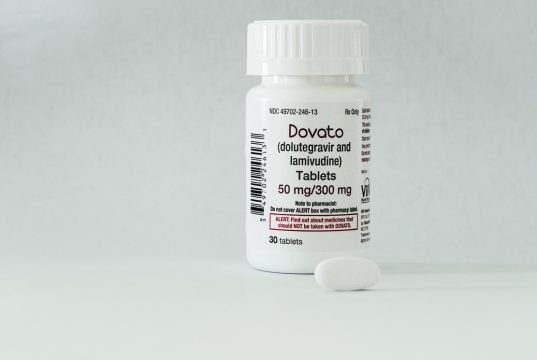Advertisment
ASH 2012 Report – New results support bendamustine-rituximab (B-R) combination as first-line treatment in patients with (iNHL) and (MCL)
Data demonstrate superior patient outcomes with B-R in first-line treatment of iNHL and MCL, compared with current standard of care.
Five sets of new data analyses presented at the 54th annual meeting of the American Society of Hematology (ASH) in Atlanta, Georgia, show that a first-line treatment regimen of bendamustine plus rituximab (B-R) results in superior patient outcomes compared with current standard of care, CHOP-R/CVP-R, in patients with indolent non-Hodgkin lymphomas (iNHL) and mantle cell lymphomas (MCL).[1],[2],[3],[4],[5]
A subanalysis of the StiL NHL 1-2003 Study, demonstrated significantly prolonged progression free survival (PFS) and overall survival (OS) for iNHL and MCL patients who achieved a complete response (CR) compared with a partial response (PR), irrespective of whether they received B-R or CHOP-R treatment.1 A CR was observed in a higher proportion of patients treated with B-R (39.8%) vs. those treated with CHOP-R (30.0%).1
Furthermore, when comparing the two treatment arms, first-line treatment with B-R resulted in superior PFS compared to CHOP-R, regardless of the quality of response:1
- For patients in CR, median PFS exceeded the five year evaluation point following B-R treatment, compared to 53.7 months for patients treated with CHOP-R (p=0.0204)1
- In patients achieving PR, treatment with B-R resulted in a median PFS of 57.2 months versus 30.9 months with CHOP-R (p=0.0002)1
Previously presented results from the StiL NHL 1-2003 Study demonstrated a significant benefit in progression-free survival (PFS) as well as improved tolerability for B-R compared with CHOP-R.[6],1
In another study presented at ASH, the Bright study, treatment with B-R was shown to produce a non-inferior CR rate compared to CHOP-R/CVP-R in patients with advanced iNHL and MCL (31% B-R vs. 25% CHOP-R/CVP-R, p=0.0225), meeting the primary objective of the study.2 Additionally the study demonstrated a significantly higher CR rate in the MCL subgroup of patients (51% vs. 24%, p=0.018).2 Response assessments were performed by an independent review committee.
A third new analysis provided results on the quality of life (QoL) of previously untreated iNHL and MCL patients on B-R treatment, compared to those on CHOP-R/CVP-R treatment, from the Bright study. Results showed that B-R treatment provided improved patient QoL scores for most aspects of functioning and symptoms.3 Furthermore B-R significantly improved global health status (GHS)/QoL compared to the standard of care CHOP-R/CVP-R (3.6 vs. -5.1 respectively, p=0.0005) in these patients.3
“Over the last year we have seen an increasingly compelling body of evidence presented that demonstrates bendamustine’s potential as a new cornerstone chemotherapy for the first-line treatment of all iNHL and MCL,” said J.G. Gribben, Professor of Medical Oncology, St. Bartholomew’s Hospital, Queen Mary’s School of Medicine, University of London. “These results not only demonstrate similar complete response rates compared with current standards of care, but also that the simplified treatment regimen of bendamustine plus rituximab leads to improved progression-free survival and quality of life with decreased toxicity for patients fighting indolent non-Hodgkin’s lymphoma.”
Two further studies provide additional supporting evidence for the use of B-R in first-line iNHL:
- A review of 645 German patients receiving systemic first-line treatment for iNHL in the clinical registry on lymphoid neoplasms (TLN Registry) suggests B-R is already the number one chemotherapy cornerstone choice in Germany for iNHL.4 B-R was the first-line treatment in 66% of cases, compared to just 16% for CHOP-R4
- The first data presented from the MAINTAIN trial, showed B-R to be effective as a treatment for Waldenström’s Macroglobulinemia, a rare subtype of iNHL.5,[7] B-R treatment achieved an overall response rate of 86%, with no uncommon toxicities observed during B-R induction.5 The MAINTAIN trial was initiated to investigate the impact of following B-R first-line induction with rituximab maintenance, a technique that has already been shown to improve PFS in previously untreated Follicular lymphoma, the most common form of iNHL5,7,[8]
A record number of abstracts, 43 in total, announcing the results of studies involving bendamustine are being presented at the ASH annual meeting, demonstrating renewed interest in this molecule as a chemotherapy partner for novel therapies across a number of B-cell malignancies, including iNHL and MCL.
“Data from the StiL NHL 1-2003 study have been submitted for a license variation and are currently under assessment by the regulatory authorities,” said Professor Pier Luigi Zinzani of the Institute of Hematology and Medical Oncology, University of Bologna. “The volume of bendamustine abstracts being presented at ASH this year also indicates the potential role of this treatment in novel combinations and across multiple different malignancies. Fundamentally, bendamustine plus rituximab offers an alternative to existing more toxic chemotherapy regimens, something that is desperately needed by the cancer community.”
NHL is the tenth most common cancer worldwide and figures from 2008 indicate that there are an estimated 356,000 new cases diagnosed every year, comprising two out of five haematological cancers.[9] iNHL represent 40% of all NHL subtypes.[10] The estimated average incidence of NHL in 2008 in the European Union is 10.8 per 100,000.9,[11]
About Bendamustine
Bendamustine was first discovered in Germany 50 years ago in what was then the German Democratic Republic (East Germany). In 2008 the US Food and Drug Administration (FDA) approved bendamustine for the treatment of iNHL and chronic lymphocytic leukemia (CLL), and it subsequently received European approval in 2010 for certain types of iNHL, CLL and multiple myeloma.
CHOP-R/CVP-R Treatment Regimens
Rituximab plus chemotherapy, most commonly CHOP or CVP, is the current first-line standard of care for patients with advanced iNHL, and mantle cell lymphoma patients who are not fit for high dose chemotherapy.[12]
CHOP, a multi-drug chemotherapy regimen, is a combination of three chemotherapy injections/infusions (cyclophosphamide, doxorubicin and vincristine) on a single day, with a fourth agent (prednisone) taken orally for five days. Each cycle is repeated every three weeks for 6-8 cycles.
CVP treatment follows a similar regimen but comprises two chemotherapy injections/infusions (cyclophosphamide and vincristine), followed by a five-day course of prednisone tablets.
For further information please contact:
Bily Kuo
+44 (0) 1223 397 118
David Carter
david.carter@fleishmaneurope.com
+44 (0) 20 7395 7188
Date of preparation November 2012, MINT/LEVA-12068
References
[1] Rummel MJ, Niederle N, Maschmeyer G, et al. Subanalysis of the StiL NHL 1-2003 Study: Achievement of Complete Response with Bendamustine-Rituximab (B-R) and CHOP-R in the First-Line Treatment of Indolent and Mantle Cell Lymphomas Results in Superior Survival Compared to Partial Response. Abstract presented at ASH 2012. Available at https://ash.confex.com/ash/2012/webprogram/Paper48063.html.
[2] Flinn IW, Van der Jagt RH, Kahl BS, et al. An Open-Label, Randomized Study of Bendamustine and Rituximab (BR) Compared with Rituximab, Cyclophosphamide, Vincristine, and Prednisone (R-CVP) or Rituximab, Cyclophosphamide, Doxorubicin, Vincristine, and Prednisone (R-CHOP) in First-Line Treatment of Patients with Advanced Indolent Non-Hodgkin’s Lymphoma (NHL) or Mantle Cell Lymphoma (MCL): The Bright Study. Abstract presented at ASH 2012. Available at https://ash.confex.com/ash/2012/webprogram/Paper51442.html.
[3] Burke JM, Van der Jagt RH, Kahl BS, et al. Differences in Quality of Life Between Bendamustine Plus Rituximab Compared with Standard First-Line Treatments in Patients with Previously Untreated Advanced Indolent Non-Hodgkin’s Lymphoma or Mantle Cell Lymphoma. Abstract presented at ASH 2012. Available at https://ash.confex.com/ash/2012/webprogram/Paper49604.html.
[4] Ulrich Knauf W, Abenhardt W, Nusch A, Grugel R, Marschner N. Bendamustine-Rituximab (BR) Replaces R-CHOP As “Standard of Care” in the Treatment of Indolent Non-Hodgkin Lymphoma in German Hematology Outpatient Centres. Abstract presented at ASH 2012. Available at https://ash.confex.com/ash/2012/webprogram/Paper53051.html.
[5] Rummel MJ, Lerchenmüller C, Greil R, et al. Bendamustin-Rituximab Induction Followed by Observation or Rituximab Maintenance for Newly Diagnosed Patients with Waldenström’s Macroglobulinemia: Results From a Prospective, Randomized, Multicenter Study (StiL NHL 7-2008 –MAINTAIN-; ClinicalTrials.gov Identifier: NCT00877214). Abstract presented at ASH 2012.
[6] Rummel MJ, Niederle N, Maschmeyer G, et al. Bendamustine plus rituximab (B-R) versus CHOP plus rituximab (CHOP-R) as first-line treatment in patients with indolent and mantle cell lymphomas (MCL): Updated results from the StiL NHL1 study. J Clin Oncol 30, 2012 (suppl; abstr 3).
[7] Cancer.Net Editorial Board. Lymphoma – Non-Hodgkin – Subtypes. Available at http://www.cancer.net/cancer-types/lymphoma-non-hodgkin/subtypes. Accessed November 2012.
[8] Salles G, Seymour JF, Offner F, et al. Rituximab maintenance for 2 years in patients with high tumour burden follicular lymphoma responding to rituximab plus chemotherapy (PRIMA): a phase 3, randomised controlled trial. The Lancet, 1 January 2011: 9759; 42 – 51.
[9] Non-Hodgkin lymphoma incidence statistics: In the EU and worldwide. Cancer Research UK. Available at http://www.cancerresearchuk.org/cancer-info/cancerstats/types/nhl/incidence/#world. Accessed November 2012. European Age-Standardised rates calculated by the Cancer Research UK Statistical Information Team, 2011, using data from GLOBOCAN 2008 v1.2, IARC, version 1.2.
[10] Gascoyne, Randy D. Hematopathology approaches to diagnosis and prognosis of indolent B-cell lymphomas. ASH Education Program Book 2005.1 (2005): 299-306.
[11] European Age-Standardised rates calculated by the Cancer Research UK Statistical Information Team, 2011, using data from GLOBOCAN 2008 v1.2, IARC, version 1.2. Available at Non-Hodgkin lymphoma incidence statistics: In the EU and worldwide. Cancer Research UK http://www.cancerresearchuk.org/cancer-info/cancerstats/types/nhl/incidence/#world.. Accessed November 2012.
[12] Gribben JG; How I treat indolent lymphoma. Blood 2007;109:4617-4626.





